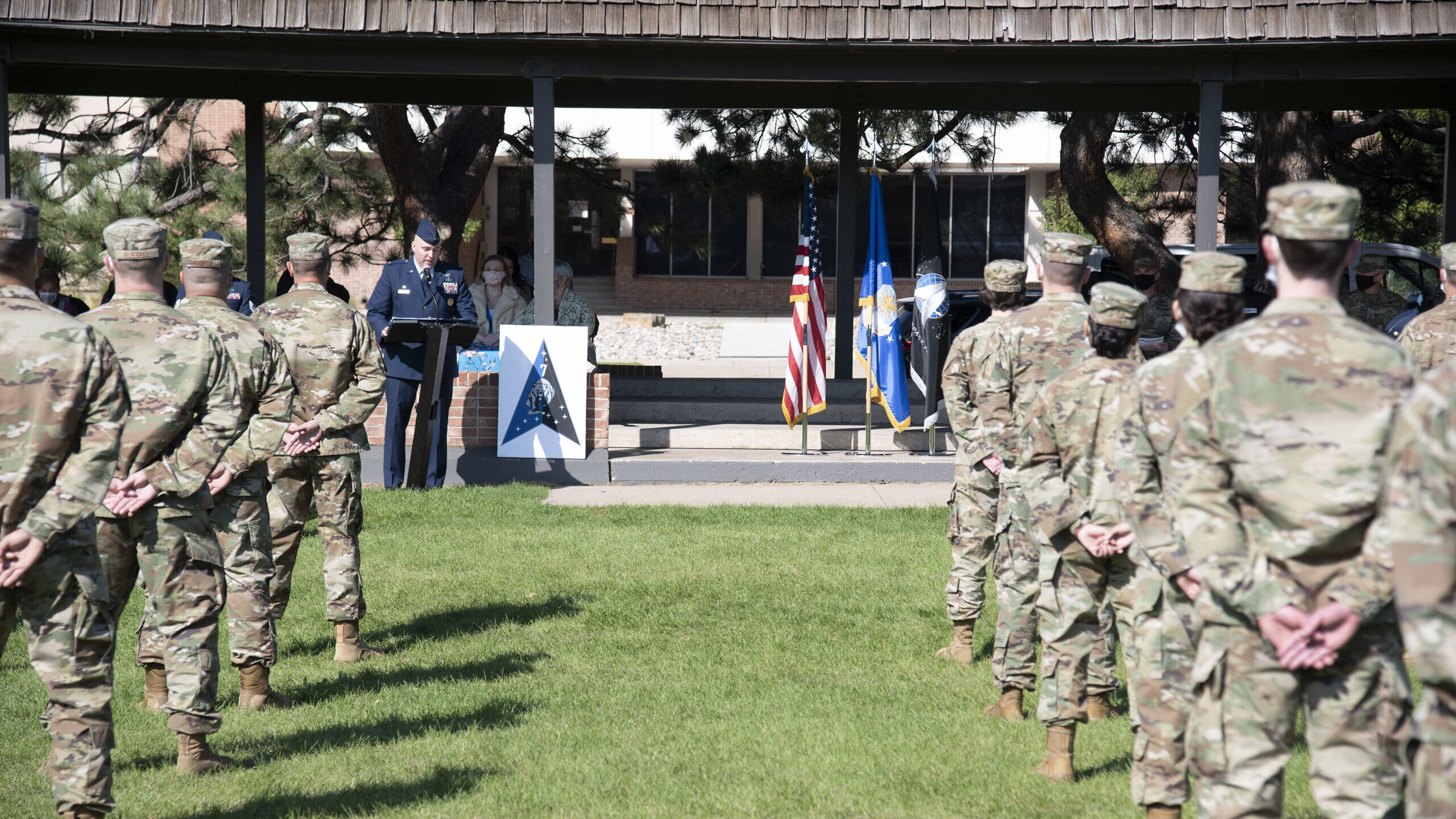
Col. Chandler Atwood, Space Delta 7 commander, speaks to new squadron members during the activation ceremony of the 71st and 72nd Intelligence, Surveillance and Reconnaissance Squadrons at Peterson Air Force Base, Colorado, Sept. 11, 2020. (U.S. Space Force photo by Kristen Allen)
WASHINGTON: In the wake of new revelations about the Trump administration’s decision to base Space Command in Alabama, lawmakers from rival Colorado fighting to keep the HQ in their state are focusing on the complaint by military leadership that the basing review did not assess how long it would take each candidate site to become fully operational.
“We are reviewing the findings of the report, and will have more to share in the coming days. Our position remains that the previous administration used a basing process for U.S. Space Command that was untested, lacked transparency, and neglected critical national security and cost considerations,” the state’s two senators, Democrats John Hickenlooper and Michael Bennet, said in a joint statement.
Then-President Donald Trump tapped Huntsville, Ala., for SPACECOM’s new home on Jan. 11, 2021, despite a briefing by senior Defense Department officials that put Colorado Springs — home of Peterson SFB and SPACECOM’s current temporary HQ — in first place as the “preferred” choice, and Huntsville as the best alternative.
However, the just-released report of the Office of the Inspector General, aimed at assuring the process was properly followed DoD and Air Force procedure, found that the choice of Alabama was “reasonable” based on the what they found was a legal and supportable review process.
Further, a draft version of the OIG report obtained by Breaking Defense, which includes a large amount of detail redacted from the final report, shows that the choice of Colorado Springs as the front-runner was made only a few days prior to the White House decision meeting. Huntsville, home of the Army’s Redstone Arsenal and much of that service’s not inconsiderable space infrastructure, actually had placed first in the basing review’s rankings.
The elevation of Colorado was made at the behest of senior military space leaders — SPACECOM Commander Gen. James Dickinson, Chief of Space Operations Gen. Jay Raymond and then Vice Chairman of the Joint Chiefs of Staff Gen. John Hyten — who argued in favor of Colorado Springs, according to the draft report.
While the draft report makes clear that all six finalist sites would be adequate to house SPACECOM HQ, Colorado actually had placed fifth out of the six.
Fixated On FOC
Key to the top brass’s arguments was that it would take less time for the new HQ to become fully operational because there would be no need for a disruptive move of personnel, computers and records.
Hickenlooper and Bennet were quick to jump on this issue, saying in their statement: “Chief among those concerns is Peterson Space Force Base’s singular ability to reach Full Operational Capability [FOC] as quickly as possible. Space Command should remain permanently based at Peterson Space Force Base in Colorado.”
Rep. Doug Lamborn, R-Colo., ranking member of the House Armed Services strategic forces subcommittee, also fixated on the issue of the time it would take to reach FOC in vowing to continue the fight.
“The DoD OIG report confirms that throughout the process the best military advice and first choice of our top commanders was to keep U.S. Space Command in Colorado Springs. … With only a cursory review of the process itself, the DoD OIG’s conclusion that the previous basing decision was reasonable simply means that it was logical based on flawed evaluations,” he said in a statement provided to Breaking Defense.
“Two of the four recommendations in the DoD OIG report are to more fully account for the imperative to quickly achieve full operational capability based on concerns raised by our military leaders that this was not adequately factored in during this basing process,” he added. “I will continue to advocate for a fair and transparent basing decision that prioritizes national security imperatives and rapidly addresses the increasing threats we face in space.”
Huntsville’s Win Was Based On SPACECOM’s Own Requirements
The draft OIG report, however, paints a much more nuanced picture of the FOC question.
First of all, the OIG’s investigation of the years-long review process shows that Huntsville clearly outpaced the other five sites that had made it to the finals based on the metrics applied.
Those metrics included four top-level “evaluation factors,” each one keyed to a number of 21 weighted sub-criteria that together totaled 100 points:
- Mission — which involved an assessment of the qualified workforce in the vicinity, including at “mutually supportive space entities” nearby;
- Capacity — infrastructure at the base, including redundant communications networks and proximity to support services;
- Community — such as quality of local schools, hospitals, etc.;
- Costs to DoD — one-time infrastructure costs, given that each of the sites under consideration included a need for new facilities to house the planned HQ staff of 1,400 personnel. (The need for new buildings was included in all of the site self-nominations by local civic authorities, including those representing Colorado Springs, that kickstarted the review process itself.)
Those evaluation factors and criteria were developed by Air Force basing office and SPACECOM personnel in July 2020, with the latter active in providing the command’s requirements and helping to weigh the supporting criteria accordingly. Indeed, SPACECOM officials worked to refine at least two of the key supporting criteria after an initial chop by Air Force basing office personnel — “available qualified workforce” and “proximity to mutually supporting space entities” — to fashion them more to the command’s perceived needs, according to the draft report.
Those metrics were then approved by then-Air Force Secretary Barbara Barrett and, in November 2020, by then-Defense Secretary Mark Esper, the OIG draft found.
Further, the metrics were subsequently briefed to interested congressional delegations, including all six representing the eventual finalists. No objections were recorded at the time, the OIG draft said. And those six delegations were briefed again following the selection of the finalists by Esper, again to no objections.
Last Minute Changes
The issue of the time it would take for the new HQ to be declared as FOC was not raised at all until January 2021, according to the OIG draft, in the preparatory run-up for the planned White House briefing. And the need to include time to FOC as a fifth “evaluation factor” was only one of the arguments in favor of Colorado Spring pushed by Dickinson, Raymond and Hyten.
Raymond and Dickinson, in comments raised during two meetings Jan. 5 and 8, 2021, put forth three arguments that Colorado Springs had unfairly been judged.
First, according to the draft OIG report, they argued that the infrastructure costs cited for Colorado Springs were too high because they were based on the need for a new building house HQ operations, which they asserted was unnecessary. That assertion was contrary to the initial bid put forward by Colorado Springs political authorities.
Second, according to the draft OIG report, they argued that the number of HQ personnel could be reduced to 1,000, which would help buttress the fact that no new facility was needed.
Finally, they argued that Colorado Springs provided “significant advantages” not reflected in the decision, including the ability to hire and retain employees, accelerate FOC, avoid mission disruption (because no move would be involved) and save money. For his part, the draft report says Dickinson told the OIG investigators that it was his opinion that keeping SPACECOM HQ in Colorado Springs could achieve FOC four to six years earlier than moving it to any other location.
Air Force basing office personnel, however, objected that changing the evaluation factors for Colorado Springs alone would be unfair ball, and that any such changes would require starting the whole basing review process all over again — which had already happened once when a first go-round was pitched out by Barrett and Esper in March 2020.
The OIG investigators agreed with that assessment, and in their final report instead recommended that current Defense Secretary Lloyd Austin undertake a review of whether time-to-FOC ought to be included as an evaluation factor for all future basing decisions. The Office of the Secretary of Defense agreed to that recommendation.
The final report also recommended that Air Force Secretary Frank Kendall review whether that factor ought to be weighed in the specific case of SPACECOM HQ, something that no doubt would be grounds for the losers in the contest to demand re-opening the contest. Kendall’s office, likewise, has agreed to undertake a review.
EUCOM asks for $83 million for air base defense in FY25 unfunded wish list
The air base defense priority is the largest of the three items EUCOM listed, with almost $67 million needed for additional sensors that would plug into the Air Force’s base defense network.



























